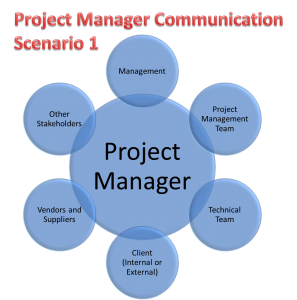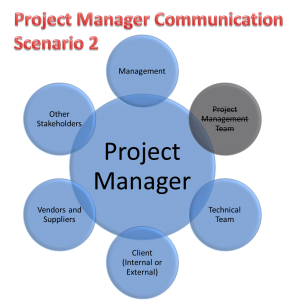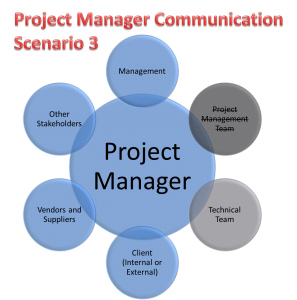Introduction
On the PMI Lebanon Chapter LinkedIn Group, There is a discussion posted by a group member per the following title: “It is frequently said and taught that a project manager should spend around 90% of his time communicating. Do you think this statistic is exaggerated?” To read more about this topic click here.
The discussion is interesting but we will not cover it here. What we want to cover is a general topic, that is important in project management, which is how do we define project communication? Further, there is a question of 90% of project manager time.
What is project communication?
In our humble opinion, the way we understand and practice project management is that communication is whenever there is a “talking / reading / writing / meeting / even signaling” between 2 people or more. A key in communication are the standard model of sender-receiver, meaning the sender need to ensure that the message is received and receiver is responsible to provide feedback to verify communication. We are not expert on communication, so we refer you to the numerous books on the subject.
The main focus here is project manager communication. However, before we discuss this point, let us address who are the other players on a given project and what are the tasks that they do.
Explaining project tasks and who perform them
We can categorize project tasks under three broad categories.
- Technical Tasks: these are the tasks that project team members (technical team members) performs depending on the project application area. So these are the engineering design tasks, programming, constructing, graphic design, business analysis, hardware installations, etc. These are technical tasks that technical people perform them to deliver the project product; whatever that is. To perform these tasks, the team will follow their unique “product/technical” processes.
- Project Management Tasks: these are tasks related to project management and to perform them we need project management processes (such as from PMI PMBOK) and we need to have competent people perform them (such as per IPMA ICB). These tasks include things like developing the schedule or cost estimate, establishing a quality plan, perform procurement activities, etc. Here we need to emphasize a key point. On small projects with limited resources the project manager end up doing these tasks … on larger projects there will be dedicated resources performing these tasks. For example, estimating would be done by a professional estimator, scheduling require an experienced planner and a scheduler, etc. In summary, who perform these tasks? The Project Management Team (PMT).
- Project Manager Tasks: we separate this from project management tasks since they are quite different and this is the heart of this article and the point of discussion. What are the project manager tasks? Let us cover this in the following section.
Project Manager Role
As we said under the previous item (No 2), on “small/simple” projects the project manager might be doing all of the project management tasks. In some situations, the project manager might even be involved in the technical tasks as a “doer” or “reviewer”. However, on larger and more complex projects, the project manager should not be doing any technical task (neither as a doer or reviewer) and quite often should not be doing any project management tasks either – those tasks are for the PMT with the project manager reviewing but … not doing.
We know the above statement is controversial and have a deeper impact on the domain of project management today. It is common that in our classes, when we share our personal backgrounds with the participants, we say that “at one time I was an estimator, or a project control engineer”. The response is quite often “what is that role”. Why such a question? Because in many application areas there is no project management team – there is only the project manager and the project manager must do it all!
What is correct? In business there is not always a correct answer.
- Scenario 1: In the purest form of project management (our opinion); the project manager should be only directing and managing … with project management tasks left to PMT and technical tasks left to technical team. This applies even in small project environment where the team members could be part timers and supporting more than one project (what we mean is PM, PMT, and Technical — all could be part timers)
- Scenario 2: In some situations, organizations might prefer that no the PM should do all (or most of) the project management tasks and no need for other specialists.
- Scenario 3: In other situations, organizations might decide that a technical person can be the lead as well and function as a project manager; this is the accidental project manager syndrome that we discussed in past articles.
What is right for you? You decide.
Back to Project & PM Communication
What does the above relate to project communication and project manager time spent on communication? Without the above necessary background we cannot answer this question properly.
 Scenario 1
Scenario 1
In the “purest” form (Scenario 1), where the project manager role is to direct and manage the project with a project management team and a technical team; then most of the time the project manager role is communication. He or she would direct team members, issue instructions, report to executive management, etc. Most of his/her time is communicating.
For example, a project planner might put a plan together but the PM is the one who communicate it or lead the communication with management. A project control engineer might perform earned value analysis and reporting so the PM need to discuss this work with the engineer then the PM will report it to management.
In other words, the PM role is mostly communications.
Does the project management effort on communication require 80%, 90%, 100%, 81.5% of his or her time? We are not sure if anyone can specifically say or if anyone did a study to actually measure this, but to us this is not relevant. What is relevant is that the PM role is mostly communicating with the various stakeholders as the first illustration shows.
 Scenario 2
Scenario 2
If we move to Scenario 2; the illustration, on the left, is the same as the earlier one but with gray shading on the project management team since in this scenario the PMT does not exist.
In this scenario, the PM will have to perform project management tasks since there is no PMT. Yet, even in this case there is still a need for a lot of communication with technical team (and all other stakeholders) but in this case the effort on communication (we think) is less than scenario 1.
Please note in this case the communication is somewhat reduced due to no PMT (one less group to communicate with) … however, the PM now has to communicate with other stakeholders, whom the PMT would have communicated with. So one side is less communication on the other there is more. The net, we think the communication effort is less than scenario 1.
 Scenario 3
Scenario 3
Finally, with Scenario 3, communication is less than the previous two scenarios for three reasons:
- There is no PMT,
- The technical team might be limited in numbers; since the PM is doing some technical work, and
- The project is possibly smaller and simpler with limited stakeholders.
Closure
In all of the above scenarios, the readers most likely noticed that we did not provide a percent since we are not sure if it is scientifically possible to measure. Consequently, we are left with a qualitative / comparative approach that one scenario would require more (or less) time for communication than another.
We welcome your views and counter argument.

Mounir,
Right on spot. Nicely articulated.
Thanks
Shashi
Thanks Shashi